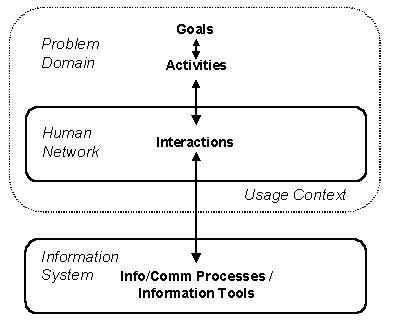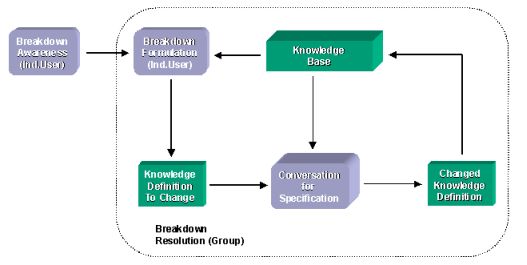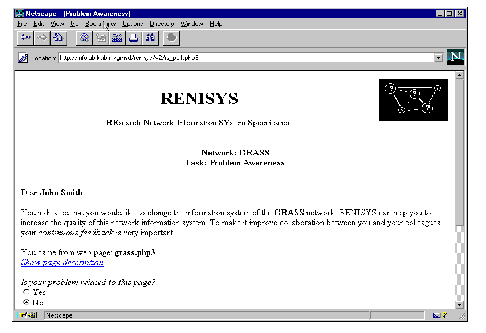Summary PhD Dissertation Aldo de Moor
Empowering Communities: A Method for the Legitimate User-Driven Specification of Network Information Systems
Collaborative work is increasingly being mediated in a distributed way. It no longer only takes place in the classical hierarchical organisation, in which detailed assignments are given top-down to groups of employees. Instead, teams of collaborating professionals are expected to set their own goals and to organise their work themselves. This kind of collaboration often entails that people coming from different organisations and distributed over a large number of locations work together intensively on complex tasks. Distributed information technologies are therefore ever more often used to support such professional networks. Especially commonly available, Internet-based information tools, ranging from mailing lists to all kinds of web applications, have a great potential to increase the efficacy of collaboration.
Research Problem
In Chapter 1, we define the virtual professional communities in which this collaboration takes place as communities or networks of professionals whose collaboration on activities required to accomplish common goals is mostly or completely mediated by information technology. In practice, however, it often turns out to be very difficult to have network technologies successfully support the distributed collaboration in such communities. One of the problems is that without a structured approach it is difficult to realize the required ongoing co-evolution of the network information requirements and supporting information tools.
To let the members of a virtual professional community work together successfully it is not sufficient to make some Internet information tools merely available. Instead, an integrated network information system (NIS) needs to be constructed out of these technological components. The selection and configuration of the tools needs to be determined by the collaborative context in which they are used. Active user participation in the specification process of these continuously evolving socio-technical systems is of great importance. The role of the users is not only to act as sources of specification knowledge, but also to control the specification process in which this knowledge is produced. This process we call user-driven.

Fig.1 The Legitimate User-Driven Specification Process
The members of virtual professional communities, just like their peers in more traditional communities, are guided in their work by social norms. These norms guide both the operational activities of the network and the specification processes in which the network is defined. However, as these networks are egalitarian by nature, the norms cannot be imposed from above, but are to emerge from the community as a whole. Thus, the user-driven specification process needs to be legitimate, in the sense that specification changes are not only meaningful but also acceptable to all community members. A specification change is acceptable if and only if the users for whom the particular change is relevant have been adequately involved in the specification process (Fig.1). In this way, all users of the NIS can see their own interests sufficiently guaranteed in the specified goals, activities, organisational structures and information technologies of the network. Such an approach should allow for more successful collaboration, not only during the initiation of the network, but also when the complexity of tasks, organisation, and supporting tools of the network gradually increases over time.
Research Questions and Objectives
In this research, the following questions have been answered:
- Why is there a need for legitimate user-driven specification of network information systems?
- What is the basis for a theory of legitimate user-driven specification?
- How can the legitimate user-driven specification process be supported?
To work out these questions, three research objectives have been formulated, each answered in a separate part of the dissertation:
- The justification and development of a theory of legitimate user-driven specification (Ch. 2-5).
- The development of a method to support the legitimate user-driven specification process (Ch. 6-7).
- The development of a prototype specification tool to partially validate the methodological approach (Ch. 8).
Subsequently, the research results concerning theory, method, and tool are presented:
Part I: Theory
In Ch.2, an analysis is made of the need for network information systems in research networks, which form an important class of virtual professional communities. Research networks are instruments for collaboration, in which individuals are motivated to participate because of a mix of individual, organisational, and societal interests. We find that it is necessary for network information requirements and information tools to co-evolve. Important assumptions regarding the collaboration in research networks are that this collaboration is situated, that operational activities and specification process occur simultaneously, that the authority for the controlling these processes needs to be distributed, and, finally, that this authority needs to be accountable.

Fig.2 The Social Context: A Reference Framework
In Ch.3, we present a model of research collaboration that is enabled by commonly available Internet information tools, such as mailing lists or web applications. These tools provide users with the functionality that they need in order to do their work. However, the usability of the tools is also of importance, in the sense that they must be both accessible and play a well-defined role in the social context. To model this context, a reference framework has been developed (Fig.2), which consists of three domains: in theproblem domain, the goals and activities of the network are represented, while the human network describes its organisational structure. These domains together are called the usage context of the information system. In the third domain, the information system, the required information and communication processes of the network are modelled. They are then mapped to the information and communication processes enabled by the available information tools. These tools, which together form the NIS, act as groupware that enables and coordinates the work of the network participants. To this purpose, the workflows of the network need to be carefully defined. The basic workflow model used, has been derived from both activity- and conversation-based workflow models.
In Ch.4, the network information system development process is defined as comprising a specification, implementation, and use process. It is established that users need to be strongly involved in the specification process of their workflows. An overview is given of existing user-centered specification methods. These are classified along two dimensions: the roles that users play (1) as sources and (2) as modellers of specification knowledge. It turns out that the class of legitimate user-driven specification methods is still underdeveloped. In these methods, the users themselves control the modelling process, and groups, instead of individuals, are considered to be the sources of specification knowledge. When a user becomes aware of a breakdown of his work, he should be able to formulate this breakdown in terms of knowledge definitions to be changed. Since these changes may affect the other members of the community, the breakdown resolution process in which definition changes are actually made and approved needs to be a group process. Only those users to whom the requested change is relevant should be involved in the resolution process. This process should be a form of rational discourse in which every validity claim made can be critically examined by the group, if needed.
Ch.5 shows how the legitimate user-driven specification process can be seen as a process of rational discourse. Theories based on the language/action perspective are well-suited to model this process. We therefore use speech act theory to represent the specification process as a conversation about a definition change, which we call a conversation for specification. However, this theory by itself is not sufficient to allow for the investigation of disputed definition-assumptions, which is essential if specification changes are to be acceptable to all members of the community. Habermas's theory of communicative action contains useful insights to this purpose, but is hard to operationalize. We therefore adapted Van Reijswoud's Transaction Process Model to represent conversations for specification as processes of rational discourse. This model can be used to analyse business communication and builds on the DEMO (Dynamic Essential Modeling of Organizations) specification method developed by Dietz. This method itself is based on speech act theory and the theory of communicative action. To ensure that only those users to whom a particular knowledge definition change is relevant are involved in its conversation for specification, the context of the conversation must be known. To determine this context, norm representations can be used. Action norms guide the operational workflows of network participants (for example, they indicate that an editor is permitted to execute an edit process). Central to the modelling of conversations for specification, however, are the so-called composition norms. These describe acceptable behaviour of network-participants at the specification level (for instance, they represent that a steering committee is responsible for changing the definition of the edit process, when required). In order to represent norms, reason about them, and to handle norm conflicts, we apply deontic theories, such as dynamic deontic logic and Stamper's MEASUR approach. Building on this interpretation of norms, we develop a context model in which both an external and an internal conversation context are distinguished. A set of applicable composition norms forms the external conversation context of a conversation for specification. Using this context, it can be determined which users can legitimately control the conversation, by initiating, executing, or evaluating it. The internal conversation context, in turn, determines which definitions are related to the knowledge definition to be changed (Fig.3).

Fig.3 Conversation in Context
Part II: Method
The RENISYS (REsearch Network Information SYstem Specification) method provides a structured approach to support the legitimate user-driven specification process.
Ch.6 presents the formal semantics of the legitimate user-driven specification process. An ontological framework describes the meaning of the network entities. We distinguish four categories of specification knowledge: type definitions, state definitions, action norms, and composition norms. We show how composition norms can be used to calculate which users to involve in the specification process in which a knowledge definition of a particular category is to be changed. The formal semantics of the conversations for specification are described. Conceptual graph theory is used to concisely represent knowledge definitions and to describe the pre and post-conditions of the various definition processes.

Fig.4 The RENISYS Method
Ch.7 explains the concrete approach offered by RENISYS to support the legitimate user-driven specification process. The method contains facilities for definition presentation, functionality specification, and the handling of global constraints on the definition processes. The methodological support of the specification process itself, that makes uses of these facilities, concentrates on the handling of breakdowns in, subsequently, the breakdown awareness, formulation, and resolution stages (Fig.4). In the breakdown resolution stage, the method provides support for conversations for specification and for discourse processes. The plausibility of the method is demonstrated by showing how the method could have been used to support the specification processes in two real world cases. One cases concerned the continuous respecification of a group report authoring process in the Internet-based Global Research Network on Sustainable Development. The second case concerned the gradual definition and implementation of a peer-reviewed editing process of the Electronic Journal on Comparative Law.
Part III: Tool
Ch.8 describes how the methodological approach has been partially implemented in a prototype of the RENISYS specification tool. It consists of a web server which can be accessed by any standard web browser (Fig.5). The architecture and functionality of the tool are briefly described. The essence of the functionality is presented by showing how the tool can be applied in an existing web software development project. The tool is currently further being developed and tested.

Fig.5 The RENISYS Tool
The thesis is ended in Ch.9 with conclusions. The results are summarized and discussed. An agenda for future research is proposed, which consists of a number of theoretical research questions as well as practical research objectives.
Our world has become a complex 'global village' which changes ever more quickly. Social, economic, political, environmental and scientific developments happen more frequently and with greater impact than ever before in history. Traditional institutions are not sufficiently capable of planning and implementing these changes, and assessing their many consequences. To substantially increase the urgently needed capacity for change, it is essential to create and nurture a multitude of professional networks, in which people who represent different stakeholders can collaborate successfully. Most of these networks can only operate, or at least become much more effective and efficient, when supported by distributed information technologies such as the Internet.
The theory of legitimate user-driven specification described in this thesis, and the RENISYS method based on this theory, may help to apply network information tools in such a way that they better meet the diverse, often unique, and very quickly changing information requirements of these virtual professional communities. Much work remains to be done on the refinement of the theory, the rigorous empirical analysis of strengths and weaknesses of the method, and the development of a robust specification tool. However, we hope that the results of the research presented in this thesis will contribute to achieving more acceptable social change.
